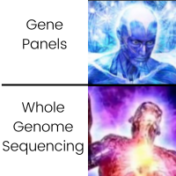The field of genomics and precision medicine is rapidly evolving, bringing forth innovative diagnostic and treatment approaches. The cutting-edge techniques and technologies discussed in the following papers provide insight into how whole-exome sequencing (WES), whole-genome sequencing (WGS), and deep computational analysis are reshaping healthcare. Our spotlight is on recent customer publications featuring the study of a unique heritable form of… Read more »
While the analysis of gene fusions is crucial for understanding the genetic basis of cancer, the process of interpreting these mutations can be challenging. One important component of fusion interpretation is the identification of relevant publications. To aid researchers in the search for publications related to specific gene fusions, Felix Mitelman, and colleagues have created the Mitelman Database of Chromosome… Read more »
VarSeq 2.3.0 unleashed a whole new way to select, process, analyze, and report cancer variants through complete workflow automation, application of evaluation scripts, and enhanced annotation. Single nucleotide variants, copy number variants, structural variants, and genomic signatures could be added to a single patient evaluation, and Golden Helix CancerKB came packed with new report-ready interpretations to support them! Soon after,… Read more »
When doing clinical variant analysis, it is often essential to keep track of the variants that are encountered in each sample, their pathogenic or oncogenic classifications, which individual created or saved an interpretation, and when. For this purpose, VarSeq prompts VSClinical users to create default assessment catalogs in which to store variants and other events. However, we are aware that… Read more »
We would like to extend our heartfelt thanks to everyone who participated in our 2023 Innovation Awards Competition. Each year, we are profoundly inspired by the innovative applications and groundbreaking research conducted using Golden Helix software globally. With immense excitement, we are thrilled to announce this year’s winner! Dr. Muthukumaran is a Team Lead and Clinical Bioinformatician at Anderson Diagnostics… Read more »
Discover how to enhance collaboration in VSClinical by sharing variant scores and assessment catalogs through the strategic relocation of the AppData folder. A subtle but powerful utility of VSClinical concerns the ability to share variant scores between users on the same account. What I mean by that is, leveraging the location of the AppData folder, so that users are writing… Read more »
At Golden Helix, our community of customers and researchers is at the core of our commitment to advancing genomic research and precision medicine. We are thrilled to highlight some recent customer publications that have made innovative use of our VarSeq software in their research. These studies, which span across diverse fields including cardiology and oncology, illustrate the versatile applications of… Read more »
In recent weeks, GenomeBrowse capabilities have had a sudden resurgence of interest among our customers. To support this, the FAS team wanted to share with you several under-utilized GenomeBrowse plotting tricks. First, let’s cover plotting a BED file for easy track viewing. The first step is launching a GenomeBrowse window by clicking the + button and selecting GenomeBrowse (Figure 1)… Read more »
We had a great time in Glasgow, connecting with many current customers and prospective customers at our booth. The in-depth conversations were engaging and offered beneficial insights for our team and the attendees. Thank you all for visiting our booth for a demo as well as attending our Corporate Satellite talk. Below are a few themes that we noticed throughout… Read more »
The AMP guidelines workflow in VSClinical provides a user-friendly tool for the interpretation of somatic biomarkers across the entire spectrum of genomic variation. One of the most useful features of this workflow is its ability to streamline the evaluation of clinical evidence for a somatic biomarker using the AMP Tier evidence levels. The AMP Guidelines classify a biomarker into one… Read more »
Discover the Latest Developments in Variant Classification and Interpretation Tools at Golden Helix’s Booth at AMP Europe 2023 in Milan, Italy We are thrilled to announce that Golden Helix will be participating in the AMP Europe 2023 conference in Milan! We are eagerly looking forward to connecting with leading healthcare professionals and researchers in the field of genetics at this… Read more »
Explore the Newest Developments in Variant Classification and Interpretation Tools at Golden Helix’s Booth at ESHG 2023 We are excited to announce that Golden Helix will be attending the ESHG 2023 conference in Glasgow! We can’t wait to connect with leading healthcare professionals and researchers in the field of genetics at this premier event. Find us in Booth #566 Be sure… Read more »
Welcome to our latest roundup of inspiring stories from the field of genomics. We are thrilled to highlight the groundbreaking work of our customers who have been utilizing Golden Helix’s VarSeq software in their scientific endeavors. VarSeq, our innovative software solution for analyzing and visualizing variant data, has enabled researchers to push the boundaries of genetic analysis. Below are three… Read more »
Explore the importance of negative findings in genomic medicine through the lens of VarSeq’s VSClinical AMP. When analyzing a somatic sample in VarSeq, users have the option to report on several types of biomarkers with VSClinical AMP. In addition to your usual mutational biomarkers such as small variants, your copy number variants, and structural variants, we support the analysis of… Read more »
Greetings VarSeq users! VarSeq 2.4.0 has officially been released. VarSeq 2.4.0 is a significant release that focuses on enhancing the VSClinical ACMG workflow by introducing new features and noteworthy improvements. The major highlights of the release are: 1. Welcoming structural variant support to the VSClinical ACMG workflow 2. ACMG workflow automation has been enhanced via the application of evaluation scripts… Read more »
In our recent webcast, we discussed the exciting new features of VarSeq 2.4.0 and the updated VSClinical interface. The discussion was centered around three main topics: In summary, VarSeq 2.4.0 uniquely supports the analysis of all variant types in the clinical interpretation workflow. By incorporating structural variants, enhancing automation, and empowering users to handle complex data, it offers a comprehensive… Read more »
Explore the evolving landscape of genomic analysis, transitioning from targeted gene panels to whole genome sequencing. A recent trend with our customers has been to expand their workflows from small panel sequencing analyses to larger whole exome and genome sequencing analyses. The decreasing cost of sequencing has made this a rather common request. Although more data allows for a greater… Read more »
Learn how VarSeq revolutionizes NGS workflows by enabling the integration of comprehensive internal databases, allowing bioinformaticians to create custom pipelines and maximize data analysis efficiency. Are you a current (or future) VarSeq user with a perfect, comprehensive, internal database you simply can’t part with and can’t replicate? Do you dream of coalescing many disparate workflows into a consistent, reliable pipeline?… Read more »
A new VSPipeline command, set_data_folder_path, designed to bolster consistent input usage. By introducing this innovative command, we aim to empower users with improved data organization, flexibility, and standardization for their clinical cases and analyses. Embracing this command will not only support reproducibility but also ensure accountability, ultimately paving the way for better-informed patient care decisions. Managing Annotations and References in… Read more »
The Bio-IT World Conference & Expo is a prestigious event showcasing the latest advancements in bioinformatics, computational biology, and data management. This year, the conference will be held in person and virtually, making it accessible to an even broader audience of researchers and bioinformatics enthusiasts. Andreas Scherer, President and CEO of Golden Helix, Inc., will be presenting a virtual talk… Read more »



